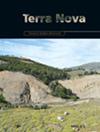火地岛(南巴塔哥尼亚)板块转换边界断层滑移率的沿走向变化
IF 1.7
3区 地球科学
Q2 GEOSCIENCES, MULTIDISCIPLINARY
引用次数: 0
摘要
马加拉内斯-法尼亚诺断层是一个活跃的走向滑动结构,容纳了南美洲和斯科舍板块之间的相对位移。由于该断层的智利部分大部分位于麦哲伦海峡的海平面以下,因此对其研究较少。我们的构造地貌研究主要集中在一个罕见的陆上断层断面上,自上一次主脱冰期以来,沿该断面水平偏移了数百米的溪流与主要的左侧断层运动学相吻合,并产生了 15.7 ± 2.4 毫米/年的滑移率。这个速率比同期阿根廷断层部分的估计速率高出 2 到 3 倍。这种空间变化可能是由于冰川对断层带的卸载和/或结构因素造成的。这些结果表明,有必要对多个部分的走向滑动断层进行研究,以揭示与内部或外部作用力有关的行为变化。本文章由计算机程序翻译,如有差异,请以英文原文为准。
Along‐strike variation of fault slip rate of a transform plate boundary in Tierra del Fuego (South Patagonia)
The Magallanes–Fagnano Fault is an active strike‐slip structure accommodating the relative displacement between South America and the Scotia Plate. The Chilean portion of the fault is poorly studied because most of it runs below the sea level in the Strait of Magellan. Our tectonic geomorphological study is focused on a rare onshore fault section, along which streams horizontally deflected by hundreds of metres since the last main deglaciation are compatible with a dominant left‐lateral fault kinematics and yield a slip rate of 15.7 ± 2.4 mm/year. This rate is between 2 and 3 times higher than the one estimated on the Argentinian portion of the fault over the same period. This spatial variation may be due to both glacial unloading on the fault zone and/or structural factors. These results point out the need to study strike‐slip faults on several portions to unravel behaviour changes related to internal or external forcing.
求助全文
通过发布文献求助,成功后即可免费获取论文全文。
去求助
来源期刊

Terra Nova
地学-地球科学综合
CiteScore
4.80
自引率
8.30%
发文量
59
审稿时长
2.3 months
期刊介绍:
Terra Nova publishes short, innovative and provocative papers of interest to a wide readership and covering the broadest spectrum of the Solid Earth and Planetary Sciences. Terra Nova encompasses geology, geophysics and geochemistry, and extends to the fluid envelopes (atmosphere, ocean, environment) whenever coupling with the Solid Earth is involved.
 求助内容:
求助内容: 应助结果提醒方式:
应助结果提醒方式:


